Lists
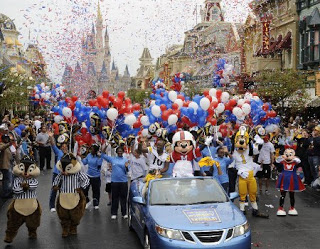
With the big game just a few hours away, I thought I'd make a list of some of the most interesting Disney links to the game of football (Sorry to any readers from other countries, I don't mean the internationally popular game of futbol. I mean good old American Football, the game you don't actually play with your feet - except for the kicker and punter, of course, but that's another story)
Here are Ten Disney Football Connections (in no particular order):
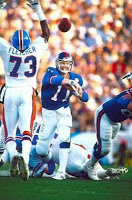 I'm Going To Disney World !!
I'm Going To Disney World !!
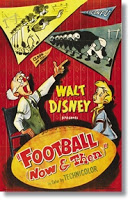 Football Now & Then (1953)
Football Now & Then (1953)
A link to "Football Now & Then" (7:53)
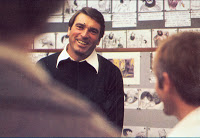 Ron Miller
Ron Miller

Moochie of Pop Warner Football
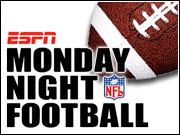 Monday Night Football
Monday Night Football
ABC already had an American institution established with "Monday Night Football" when Disney acquired the company in 1996.
From its first airing in September 1970, the show was a consistent ratings winner. Millions tuned in, not just to see the game, but also for the chemistry and antics of the announcers, led by the sometimes controversial Howard Cosell.
By the late 90's, Cosell was long gone and the show, while still popular, was losing some of its steam. Disney didn't tinker with it at first, but then they started putting their imprint on it by using cross-promotion and stunt casting.
The first tiny step was to move the show's airing from the traditional 9PM spot to 8PM, and to start off with a pre-game show hosted by ESPN's Chris Berman (The all sports cable network had become part of the Disney family with the ABC merger.) This show was not broadcast from the site of the game, but live from the ESPN Zone, Disney's new restaurant/sports bar in Baltimore (versions would also open in Orlando, Anaheim and Times Square among other places.)
In 2000 Disney added a stand-up comedian, Dennis Miller, to the announcer's booth. Miller, famous for his work on "Saturday Night Live" and his eponymous HBO series, was hired to add his wit and "outsider's" insight to the broadcast. Fans and football traditionalists were outraged. Many thought Miller's intelligent brand of humor, utilizing obscure and arcane references which required viewers to run to the nearest encyclopedia and thesaurus, was not a good fit for an NFL broadcast. Ratings went up for a bit, but the experimental move was largely seen as a bust. Miller left after two seasons.
Entertainers had always visited the Monday Night Football booth, but the appearances increased greatly under Disney's watch. This was no coincidence. While ABC used to have the stars of their network's shows pop by, Disney now had movies, books, music and park promotions to tout. Again, many football fans bristled at the intrusion as the game seemed to become secondary sometimes to the banter about each special guest's agenda.
In 2002, Disney scored a coup by luring John Madden, the most famous football commentator around, to join the Monday Night booth. They teamed him with Al Michaels in a more traditional - for the NFL - two man announcing setup. This brought stability to the show, but ratings were in serious decline and the NFL - citing flexibility and bigger potential ratings - wanted to have their marquee match ups played on Sunday night. The end of an era was about to come.
In 2006, Disney moved Monday Night Football to ESPN. In the bidding for the contract to show the premiere NFL games on Sunday night program, ABC bowed out and let NBC/Universal have the upper hand. (They also got announcer Al Michaels in a straight up trade with Disney for - and this is unbelievable - the rights to Walt's first cartoon character Oswald the Lucky Rabbit, the one that was taken away from him by Universal in 1928.)
Disney was heavily criticized for the move from network to cable, but it made much fiscal sense as they could sell more advertisements and charge more subscription fees to cable and satellite companies for the broadcast.
The game has since gone back to its roots, concentrating more on the game and its elements and analysis, and less on the show business pop ins and razzle dazzle. While Monday Night Football doesn't see the ratings numbers and attention it did on "free" TV, it's still among the highest rated cable broadcasts for the year, has broken cable ratings records and is the most profitable franchise on cable TV. Disney is smiling all the way to the bank.
 Gus (1972)
Gus (1972)
Ron Miller still had great connections with the NFL when he decided to go ahead with this feature film about a football playing mule.
As a result, Miller got full cooperation from the league to use its name and logos (not an easy thing to do) film scenes at actual NFL games, and to secure appearances from Hall of Fame legends like Dick Butkus and Johnny Unitas.
The film is about Gus, the aforementioned mule, and his owner, Andy Petrovic, who are discovered on their farm in Yugoslavia when Gus kicks a soccer ball over a hundred yards and the local papers write about him.
Don Knotts plays the coach of the California Atoms, a sad sack last place NFL franchise. He recruits Gus and Andy to turn things around, and predictable mayhem ensues on the way to a last second Super Bowl victory.
Legendary announcer Dick Enberg announces games in the film and there are plenty of NFL in-jokes. (For instance: Andy tells the team at one point that Gus will "kick a touchdown" which is a sly reference to Dolphins kicker Garo Yepremian's notoriously screaming the very same thing at his teammates in the 1972 Super Bowl.)
The film was one of the few hits Disney had in the 1970's, and it' s still well loved by football and Disney fans alike.
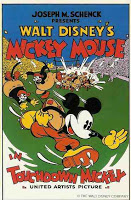
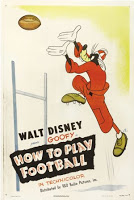 Touchdown Mickey (1932)/Goofy's How To Play Football (1944)
Touchdown Mickey (1932)/Goofy's How To Play Football (1944)
Link to watch Goofy's How To Play Football (7:10)
Link to watch Touchdown Mickey (6:32)
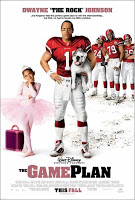

Remember The Titans (2000) Invincible (2006) The Game Plan (2007)
Disney, like most entertainment companies, caught on to the enormous popularity of football as the 20th Century came to a close.
Luckily for them, they also had an all sports network and Monday Night Football to capitalize on that. In 1999 they decided to produce their first film in decades with a football theme.
This being Disney, they also needed to find a film with an inspirational message. "Remember The Titans" fit the bill nicely.
Made in conjunction with Jerry Bruckheimer (a partnership that would work well for Disney) the film tells the tale of an African-American high school coach in 1970's Virginia, played by Denzel Washington, who takes over from a legendary white coach and struggles to overcome racist attitudes as he also tries to build a winner.
The film was a critical and financial success, and it led Disney to produce a second football themed inspirational film a few years later, "Invincible."
Like "Gus" before it, "Invincible" was able to get the cooperation of the NFL and the use of its logos. It's based on the true life story of Vince Papale, played by Mark Wahlberg.
Papale was a neighborhood guy who was given a walk on tryout by the Philadelphia Eagles and wins a spot on the team, succeeding beyond all expectations. Greg Kinnear plays real life coach Dick Vermiel. To research the role, Kinnear actually followed Vermiel around during his last year as coach of the Kansas City Chiefs.
Ironically, it was a short piece produced by NFL films about Papale that brought his story to Disney's attention when it aired on Monday Night Football. They saw great potential in it and were rewarded with another hit.
For their most recent football film, Disney went back to comedy, hiring former wrestler and college football player Duane "The Rock" Johnson to play a star NFL quarterback. (Though unlike the previous films, the NFL did not grant rights to use team names, so instead of the New England Patriots, he played for the fictional Boston Rebels.)
The humor in the plot comes from the unexpected arrival of the quarterback's 8 year old daughter, just as he is gearing up for the playoffs. This leads to all sorts of comic situations, including one where Johnson's character joins the ballet to help his daughter. (Some say this was a tribute to ESPN/Disney employee Lynn Swann, an analyst and former Super Bowl hero for the Steelers who famously took ballet lessons to help him with his agility.)
Like the other two Disney football movies of the 2000's, "The Game Plan" was a success and showed the company that football fans could also pack a multiplex.
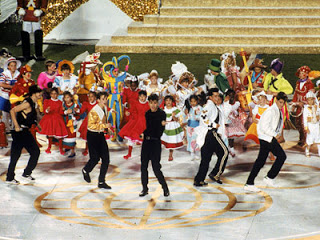
Super Bowl Half Time Shows
For the first nine years of the Super Bowl's existence, before it became a national holiday and media extravaganza, the half time show was made up of local college and high school marching bands, as per football tradition.
Super Bowl X broke with that tradition and hired the squeaky clean musical youth group Up With People to perform. they were well received, but the NFL wanted even more spectacle.
If you're going to hire a company for big entertainment on a national stage, you can't go wrong with Disney.
So at Super Bowl XI in 1977, as the Minnesota Vikings and Oakland Raiders headed to their Rose Bowl locker rooms at the half, Disney characters took the field to perform a tribute to "It's A Small World." (Basically a big commercial for the park just a few miles down the road.) This was also the first time that the Super Bowl stadium crowd was asked to be part of the spectacle. Disney distributed the now commonplace placards to be waved and held up at certain points of the performance. The times they were a changin.'
Disney returned to the Super Bowl seven years later in Tampa (again right in the Mouse's backyard) with a "salute to the silver screen." In addition to Disney characters, they utilized the marching bands of not one, but two teams, Florida State and the University of Florida. It was a big Busby Berkeley type spectacular and set the tone for halftime shows to follow (It also was the highlight of what was a rather boring blowout game as the Raiders crushed the Redskins 38-9.)
Link to a documentary about Disney's Super Bowl XVIII half Time show (8:06)
Super Bowl XXI in 1987 returned to the Rose Bowl and featured the Giants vs. the Broncos (it was the very same Super Bowl where Disney began its "What's Next?" ad campaign - see above.) This was also the 100th Anniversary of movie making, so Disney was hired to do a "salute to Hollywood."
Being so close to LA, and with millions watching, you'd expect a load of Hollywood luminaries to show up, right? Nope, just George Burns and Mickey Rooney (well the Disney gang showed up too - in costumes no less - but I'm talking about live action stars.) The Grambling University marching band performed, and there was a pre-taped medley of Hollywood songs, from Flashdance and Footloose to "When You Wish Upon A Star" (of course.)
Definitely a spectacle and not meant for hardcore football fans, the half time show of SB XXI started to drag the previously nondescript fifteen minute filler between halves into the territory of more of a Broadway or theme park style show.
A link to the Super Bowl XXI "Hooray For Hollywood" half time show (9:14)
Tampa was the setting for Super Bowl XXV in 1991, and it was no ordinary event. First, it was the 25th game, so that added to the pageantry. More important though, the game was played in a highly charged and tense atmosphere.
Just a few weeks before, US forces had begun the assault on Iraq in the first Gulf War. Almost everyone at the game was wearing red, white and blue and American flags were seen all over the Stadium. Security was tight and Whitney Houston's rendition of the National Anthem brought many to tears.
Unfortunately for Disney, their half time show was planned well in advance of the war and didn't feature overtly patriotic themes, Instead, it was another commercial, a tribute to It's A Small World. (Yes, again, this time for the Florida park, not California.) New Kids On The Block came out to sing their hit single "Step By Step."
Too bad almost nobody saw it.
Unlike all the other Super Bowl half time shows, which cost a fortune and are designed to be seen by millions, this program was not carried live by the network (ABC, before Disney purchased them.) Only the people in the Stadium saw the show. At home, viewers instead saw a special ABC News report on the Gulf War. This was just as well, as most minds were on that topic anyway and the game was just a brief respite from the almost 24 hour news coverage.
To be fair, ABC did tape the half time spectacular, intending to air it after the game, but most affiliates cut away from that too. It later re-aired on the Disney Channel.
Though hardly anyone remembers the Disney show, few can forget the game, which turned out to be one of the most exciting ever. The New York Giants won 20-19 in a last minute squeaker when the Buffalo Bills kicker missed an easy game winning field goal. (Disney was actually good luck for the Giants, as they were a part of the team's first two Super Bowl winning games.)
A link to the "invisible" Super Bowl XXV half time show (4:02)
1995 saw possibly the weirdest half time show ever, courtesy of Disney. Super Bowl XXIX was played in Miami between the Chargers and 49'ers. The game was another dud, as Steve Young threw for a record six touchdowns on the way to a 49-26 unmemorable blowout victory for the 49'ers. Those that saw the half time show could not forget it.
The theme was "Indiana Jones and the Temple of the Forbidden Eye." Wait, you say, isn't that the name of the ride that opened at Disney Land in 1995? How perceptive. Yes, Disney was, once again, using this national spotlight for a commercial about themselves.
Actors playing Indy and Marian (definitely NOT Harrison Ford or Karen Allen) steal the Vince Lombardi Trophy (the shiny silver Tiffany made award given to the Super Bowl winner) and try to save it from the bad guys all while musicians such as Tony Bennett, Teddy Pendergrass, Gloria Estefan and Patti Labelle sing in the background.
Really, I'm not making this up.
The climax of this dizzying mass of pop culture confusion was the whole group getting together at the 50 yard line to sing "Can You Feel The Love Tonight" from the previous year's hit "The Lion King." Sheesh!
Not sure what Disney was thinking there, but perhaps they believed that they would have many other opportunities to redeem themselves at the Super Bowl.
Unfortunately for them, they only had one more.
A link to the "Indiana Jones" Super Bowl XXIX half time show (5:34)
Super Bowl XXXIV in 2000 would be (to date) the last time Disney was involved in a half time show.
For the match up in Atlanta between the Rams and Titans (which the Rams won 23-16 on an exciting last second tackle at the goal line.) Disney prepared an inspiring halftime show about the hopes for the new Millennium called "Tapestry of Nations." How nice, a show written just for the Super Bowl. Oh right, "Tapestry" was also making its debut as the focus of Epcot's Millennium celebration. Once again, Disney didn't let the national attention go to waste promotionally.
This show was by far Disney's most ambitious, featuring breathtaking costumes, pageantry, a full orchestra, cast of hundreds and a chorus of 80 people. Noted actor Edward James Olmos was the narrator, and performers such as Phil Collins, Christina Aguilera (who both had Disney ties) and Enrique Iglesias took the field to sing "Celebrate the Future, Hand In Hand.".
Many thought the show was moving and impressive, but critics were not so nice. The consensus seemed to be that Super Bowl half time shows were getting too large and out of hand.
A link to Super Bowl XXXIV "Tapestry of Nations" half time show (9:58)
While the criticism was not aimed at Disney directly (Radio City Productions had also done large half time shows) the NFL decided to move in another direction. MTV and various concert promoters were asked to bring in big name rock, rap and pop stars to perform at the half, eschewing the "themed" programs. In recent years, it's been pared down even more to just one featured performer or group, often on a bare bones stage.
The NFL may yet return to Disney (there was talk of using them for guaranteed family friendly shows after the Janet Jackson "wardrobe malfunction" fiasco in 2004, but nothing came of that.) For now, Mickey and friends are on the sidelines but in the minds of millions they will always be associated in one way or another with halftime.
 Son Of Flubber (1963)
Son Of Flubber (1963)
Walt Disney detested sequels. He thought every film should be original. Given that his personal motto was "keep moving forward", producing sequels was viewed by him as just plain lazy and resting on laurels.
When he saw the money roll in from 1961's "Absent Minded Professor", Walt softened his stance a bit.
While still opposed to revisiting the previous film, Walt wanted to keep Fred MacMurray in the Disney stable, so he approved production on the Disney Studios very first sequel, 1963's "Son Of Flubber." Both men saw this new film as a logical continuation of Professor Ned Brainard's story.
Once again, Brainard has to deal with the consequences of his discovery of the mysterious substance known as Flubber. While he thought it would make him rich and famous, it actually does the opposite, leaving hm with a large tax bill. He then comes up with a substitute called Flubbergas.
While Flubber was used to help tiny Medfield College win basketball games in the first film, Flubbergas is used to give their football team an edge over larger opponents in this film (OK, maybe it's not a complete departure or continuation.)
There are two iconic images from "Son Of Flubber." One is of a Medfield football player who has inhaled Flubbergas blowing up like a balloon and floating away. The second is of the winning kick in the climactic game sailing through the uprights and off into outer space.
Because of the special effects involved, much of the football footage was shot on an indoor replica of the outdoor field used for establishing shots. These scenes were done at the Disney Studios soundstages and the professional football players hired to play Medfield's opponents were confused at having to play football inside of a building.
A link to the big football scene from "Son Of Flubber (10:56)
Two interesting casting notes: this was the first major film role for "Hollywood Squares" staple Paul Lynde, who played (improbably) a football announcer. It also was the onscreen debut of Walt Disney's grandson (and son of Ron Miller, who also co-produced the film) Walter Elias Disney Miller, who has a cameo as a small child in a television commercial.
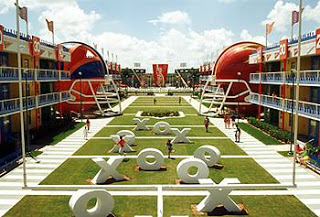
- Friday Round Up
I'm not sure why, but I love seeing mashups and reimaginings of Disney things, particularly Disney princesses. Perhaps it's having grown up with them, there's that nostalgia factor, or perhaps a girl never truly grows out of her princess...
- Glee 2x11 "the Sue Sylvester Shuffle"
You know, I remember a time last season when this show had a very similar plot about the football players doing a dance number. Remember? Single Ladies? In fact, lots of the storylines on this show are the same week after week. The glee club gets slushies,...
- Disney's Irish Connections (the People)
First, to my faithful readers, apologies for the one month gap between posts. My "day job" is as an actor and days on the set can be long (a lot of "hurry up and wait" involved) and laptops are often not permitted. I wrote lots of posts in my head, but...
- Ten Disney Icons
Copyright Disney - All Rights Reserved Most companies are lucky if they have one identifiable icon that the general public can immediately recognize and associate with that particular brand. Disney has been blessed to have so many of them...
- Top 10 Best Football Clubs In The World
Football is the most famous game in the world. Football attracts fans from all over the world. No matter where you go, you will always find football fans in huge numbers, there have been many great football clubs who have produced legends of the...
Lists
Ten Disney Football Connections

With the big game just a few hours away, I thought I'd make a list of some of the most interesting Disney links to the game of football (Sorry to any readers from other countries, I don't mean the internationally popular game of futbol. I mean good old American Football, the game you don't actually play with your feet - except for the kicker and punter, of course, but that's another story)
Here are Ten Disney Football Connections (in no particular order):

Link to first "I'm Going To DisneyWorld!" ad (:30)
Officially called "What's Next?" This iconic advertising campaign was launched after Super Bowl XXI in 1987.
New York Giants quarterback Phil Simms, the game's MVP, was asked as he was running off the field following the victory, "Hey Phil Simms, you just won the Super Bowl, what are you going to do next?" His answer, "I'm gonna go to DisneyWorld!" was said with a big grin on his face, and it seemed like a true impromptu answer. In reality, it was scripted for him, and he was paid $75,000 for his one line response.
The ad, which featured a montage of Phil Simms' heroics in the game against the Denver Broncos underscored by "When You Wish Upon a Star" and finishing with fireworks at Cinderella Castle, began airing just a few days after the Super Bowl and was a smash hit. Almost instantly the line "I'm going to Disney World!" became a national catchphrase and an indelible part of the pop culture landscape. It was soon parodied on TV shows and movies and imitated in other advertisements. Disney CEO Michael Eisner gives credit to his wife Jane for the idea, which she says she came up with after overhearing a friend who had just completed a hard task reply "I'm going to Disneyland" when asked what they were doing next.
In addition to Super Bowl winners, Disney produced "What's Next?" commercials with champions from other sports, as well as with Santa Claus, college graduates at commencement and American Idol winners.
Disney ran the spots for 17 consecutive Super Bowls until 2005, when they decided to focus their marketing campaign in other directions. The public outcry convinced Disney to return to the spots. They did a pre-game commercial in 2006 with members of both the Pittsburgh Steelers and Seattle Seahawks (who played that year in Super Bowl XL) practicing how they would say the line if they won. (The real honor eventually went to the Steelers Hines Ward and Jerome Bettis.)
The ads stick mostly to football now, and often feature more than one athlete (they also have them say two lines, "I'm going to Disney World" and "I'm going to Disney Land" for commercials specific to both coasts) but they almost never fail to bring the same lump in the throat they did when first aired almost 25 years ago.

A link to "Football Now & Then" (7:53)
Made towards the end of the great era of cartoon shorts, just as theaters began phasing them out and TV took prominence, 1953's "Football Now & Then" capitalized on and poked fun at the changing attitudes in American sports and culture.
In the first half of the 20th Century, professional baseball, boxing and horse racing were the dominant forces on the American sporting scene. Football, at least the professional version, was relegated (no pun intended) to the sidelines. Most of the great football players gained their fame in college, and all of the great football stories at the time were legends of gridiron battles between universities (Notre Dame vs. Army, Michigan vs. Michigan State, etc.) The NFL, mostly played in the Midwest and Northeast, had a core group of followers, but didn't have much respect.
The 1950's were the beginning of the sea change in sports. Teams like the NY Giants, Chicago Bears and Baltimore Colts began playing a faster brand of football, with epic clashes and "smash mouth" match ups. America started to take notice.
We look back at football in the 1950's as almost genteel, with much smaller players than the behemoths that take the field today (and with less equipment.) In those days, the changes they made to update the game were viewed with distaste by the crowd that fell in love with the collegiate brand of football of the 1920's. This "new game" was being embraced by the generation that was coming of age in the 1950's, and started to creep into even the college game. Many arguments ensued about the good old days versus today in sports loving households.
Thus the premise of this cartoon. A grandfather and grandson go back and forth over the differing styles of football as they watch a game on TV between Bygone University and Present State (not much subtlety there.) The game itself is a clever encapsulation of the changes and of the history of the game. Old Timers are shown using the "flying wedge" and - in some rather prescient scenes - the modern team is seen utilizing aids such as communication devices, psychological motivation, coaches stationed high above the stadium and even nutritional supplements. The game concludes in a deadlock, so neither argument gets the upper hand.
With "Football Now & Then" Disney seemed to understand the power of televised football, just a few short years before the NFL began its rise to the title of most popular sport in the U.S.
The punch line to the short was also a sly way of bemoaning the plight of theatrical shorts at the hands of television and acknowledging the blossoming post-war consumer culture. Grandpa becomes so enraptured and hypnotized by the "newfangled TV gadget" that when the game ends, he immediately drops the football argument and goes out to buy the products mentioned in the commercials

When Walt's oldest daughter Diane was attending school at USC in the 1950's, she met and fell in love with a promising tight end from the football team. His name was Ron Miller.
It must have been intimidating dating Walt Disney's daughter, but when Diane brought Miller home to meet her Dad, the two men formed an instant rapport. Walt, who never had a son of his own, took Miller under his wing.
Miller married Diane, had their first son Christopher, and left college early to sign with the Los Angeles Rams. Walt came to see one of his games, wherein Miller took a brutal hit and was knocked out cold. Walt feared that Miller might be killed on the field in such a violent game, so he suggested that he leave the NFL and come to work at the Disney Studios. He was grooming him to be his successor someday.
Nether man realized how soon that day would come. After producing just a few films with Walt ("the Monkey's Uncle", "That Darn Cat!", "Monkeys Go Home!" among others) Miller was thrust into a leadership role following Walt's unexpected death in 1967.
Ron Miller's tenure as Disney's Executive Producer and later Company President was a rocky one, to say the least. He was in office during the time when the animation department's luster dimmed. Most of the live action films were flops as well. The blame was placed unfairly on his shoulders because he was seen as a former football jock who got lucky by marrying Diane. In reality he was doing what many others at the company were doing, trying to figure out how to keep Disney's brand current in the shifting cultural landscape of the 1970's, while at the same time honoring the values Walt set down.
The bitterness and backbiting against Miller led to his departure from the company in 1984, as Michael Eisner and his crew took over. Despite the criticism, Ron Miller is widely credited with such innovations and positive additions to the company as the Disney Channel and Touchstone Pictures (which was a clever solution to the dilemma of how to release films with more mature subjects without directly using the Disney name.) Miller also saw the coming domination of computer technology in movies (a full 20 years ahead of the curve) and green lit the development of the groundbreaking film "Tron" and the development of the computerized CAPS system for animated films, the DNA of Pixar and all the others.
Ron and Diane Miller are still married and run a successful winery in Northern California. They also opened the independent Walt Disney Family Museum at the Presidio in San Francisco to pay tribute to their family's legacy.

Moochie of Pop Warner Football
Kevin Corcoran is a Disney legend, famous for his breakout roles as a child star in films like "Old Yeller", "Toby Tyler" and "Swiss Family Robinson." It was his appearance in 1959's "The Shaggy Dog", however, that gave him an enduring onscreen nickname.
Corcoran's character in that film, Moochie, was later reprised on popular Disney TV mini-series in the late 1950's and early '60's. These shows often featured the typical life of a young boy in that time period. Moochie was a clean cut paper boy with a bit of a mischievous streak who always does the right thing in the end. (He was basically a cousin of Beaver Cleaver and other TV children of the era.) In each episode, he would get in a jam, have a dilemma and basically have it solved neatly with a moral at the end.
One of the most beloved of these Moochie stories was "Moochie of Pop Warner Football" which originally aired around Thanksgiving in 1960 (and shown in reruns and syndication many times over since then.)
As you can guess from the title, the program chronicles Moochie's time as a pee-wee football player on his local Pop Warner football league (named for Glenn "Pop" Warner - a legendary Hall of Fame coach - these leagues are the American football equivalent of baseball's Little Leagues.)
Of course a TV episode wouldn't work without some conflict, so it comes here in the form of Moochie's rivalry with the Mayor's son, who is on the same team. After resolving their dispute happily, they learn to work together and the team goes on a winning streak. This leads them to the climactic moment, a chance to play in the "Disneyland Bowl", which included a visit to the park.
Never one to miss a promotional opportunity, Walt Disney himself makes an appearance in the show as the children are shown enjoying a day at the then 5 year old park as their reward.
Now a nice piece of nostalgia from that period, the show was applauded by Pop Warner Leagues all over the U.S., who saw their membership numbers rise every time the show re-aired.

ABC already had an American institution established with "Monday Night Football" when Disney acquired the company in 1996.
From its first airing in September 1970, the show was a consistent ratings winner. Millions tuned in, not just to see the game, but also for the chemistry and antics of the announcers, led by the sometimes controversial Howard Cosell.
By the late 90's, Cosell was long gone and the show, while still popular, was losing some of its steam. Disney didn't tinker with it at first, but then they started putting their imprint on it by using cross-promotion and stunt casting.
The first tiny step was to move the show's airing from the traditional 9PM spot to 8PM, and to start off with a pre-game show hosted by ESPN's Chris Berman (The all sports cable network had become part of the Disney family with the ABC merger.) This show was not broadcast from the site of the game, but live from the ESPN Zone, Disney's new restaurant/sports bar in Baltimore (versions would also open in Orlando, Anaheim and Times Square among other places.)
In 2000 Disney added a stand-up comedian, Dennis Miller, to the announcer's booth. Miller, famous for his work on "Saturday Night Live" and his eponymous HBO series, was hired to add his wit and "outsider's" insight to the broadcast. Fans and football traditionalists were outraged. Many thought Miller's intelligent brand of humor, utilizing obscure and arcane references which required viewers to run to the nearest encyclopedia and thesaurus, was not a good fit for an NFL broadcast. Ratings went up for a bit, but the experimental move was largely seen as a bust. Miller left after two seasons.
Entertainers had always visited the Monday Night Football booth, but the appearances increased greatly under Disney's watch. This was no coincidence. While ABC used to have the stars of their network's shows pop by, Disney now had movies, books, music and park promotions to tout. Again, many football fans bristled at the intrusion as the game seemed to become secondary sometimes to the banter about each special guest's agenda.
In 2002, Disney scored a coup by luring John Madden, the most famous football commentator around, to join the Monday Night booth. They teamed him with Al Michaels in a more traditional - for the NFL - two man announcing setup. This brought stability to the show, but ratings were in serious decline and the NFL - citing flexibility and bigger potential ratings - wanted to have their marquee match ups played on Sunday night. The end of an era was about to come.
In 2006, Disney moved Monday Night Football to ESPN. In the bidding for the contract to show the premiere NFL games on Sunday night program, ABC bowed out and let NBC/Universal have the upper hand. (They also got announcer Al Michaels in a straight up trade with Disney for - and this is unbelievable - the rights to Walt's first cartoon character Oswald the Lucky Rabbit, the one that was taken away from him by Universal in 1928.)
Disney was heavily criticized for the move from network to cable, but it made much fiscal sense as they could sell more advertisements and charge more subscription fees to cable and satellite companies for the broadcast.
The game has since gone back to its roots, concentrating more on the game and its elements and analysis, and less on the show business pop ins and razzle dazzle. While Monday Night Football doesn't see the ratings numbers and attention it did on "free" TV, it's still among the highest rated cable broadcasts for the year, has broken cable ratings records and is the most profitable franchise on cable TV. Disney is smiling all the way to the bank.

Ron Miller still had great connections with the NFL when he decided to go ahead with this feature film about a football playing mule.
As a result, Miller got full cooperation from the league to use its name and logos (not an easy thing to do) film scenes at actual NFL games, and to secure appearances from Hall of Fame legends like Dick Butkus and Johnny Unitas.
The film is about Gus, the aforementioned mule, and his owner, Andy Petrovic, who are discovered on their farm in Yugoslavia when Gus kicks a soccer ball over a hundred yards and the local papers write about him.
Don Knotts plays the coach of the California Atoms, a sad sack last place NFL franchise. He recruits Gus and Andy to turn things around, and predictable mayhem ensues on the way to a last second Super Bowl victory.
Legendary announcer Dick Enberg announces games in the film and there are plenty of NFL in-jokes. (For instance: Andy tells the team at one point that Gus will "kick a touchdown" which is a sly reference to Dolphins kicker Garo Yepremian's notoriously screaming the very same thing at his teammates in the 1972 Super Bowl.)
The film was one of the few hits Disney had in the 1970's, and it' s still well loved by football and Disney fans alike.


Link to watch Goofy's How To Play Football (7:10)
Link to watch Touchdown Mickey (6:32)
Disney's interest in football was evident early on, as illustrated by these two shorts from the nascent days of the company.
The first, 1932's "Touchdown Mickey", was the 47th appearance of the most famous cartoon mouse in the world, at the height of his popularity. It even begins with Mickey's own football fight song called "Rah Rah Mickey!"
This black & white cartoon depicts a gridiron battle between Mickey's team, called Mickey's Manglers, and a team led by his nemesis, Pete, called the Alley Cats. We pick up the action in the last quarter, as Mickey's team is struggling to tie the game. In addition to the traditional football action (flying wedge, halfback option) the short is chock full of gags, which was characteristic of the Disney shorts at the time. (Many of these slapstick visual jokes were actually written by Walt himself in those days.)
In the end, Mickey's gang prevails (it must have been some match up, as the score gets to 96-96 by the time we come in to the story.) Mickey wins the game by plowing UNDER the goal line after a mad scramble for the ball involving mud, mustard, a wealthy pig and a few other obstacles. (That last sentence probably made no sense. Watch the cartoon, you'll see what I mean.)
The most interesting part of the film is that it also features four of Disney's "Fab Five" core characters (Mickey, Minnie, Goofy and Pluto.) Donald Duck would not officially make his screen debut or a few years, but there is a cheerleading chorus of ducks in the picture, so that sort of counts I guess.
An early version of Goofy (still called Dippy the Goof) is the frazzled announcer, Pluto is the waterboy, and Minnie is - as always - Mickeys sweetheart, greeting him at the end of the game with a big kiss on top of the goalpost.
It's a fun romp, and also one of the more violent Mickey shorts, with players being pummeled left and right. (Mickey ends the film bandaged and bruised as well.)
By 1944 Goofy had evolved into a character in his own right, and Disney put him to work in a series of mock "how to" instructional films. (Almost half of his shorts featured this theme.)
"How To Play Football" should definitely NOT be used to teach a youngster the rules. It's a tongue in cheek look at the game. In the first few minutes the announcer/narrator proceeds to give an explanation of how the game is played, but is drowned out by the crowd at the college football game we are meant to watch.
The clash is between Taxidermy Tech and Anthropology A&M, two teams populated entirely by Goofy clones in leather helmets. Actually, Goofy plays all the parts in this film, from coach to referee and even the half time cheerleaders! In the end, Tech wins by the improbable score of 13 - 12 1/2, thanks to a deflated football that didn't quite go over the goal post.
For one of the few times in his on-screen career, Goofy (or his clone) makes reference to the fact that he's actually a dog, not human. At one point the announcer says "The quarterback barks the orders!" and Goofy does just that, gets on all fours and barks. It's as jarring as seeing Pluto on two legs and talking.
Both films are a nice time capsule look at the way football was played before the modern NFL era.


Remember The Titans (2000) Invincible (2006) The Game Plan (2007)
Disney, like most entertainment companies, caught on to the enormous popularity of football as the 20th Century came to a close.
Luckily for them, they also had an all sports network and Monday Night Football to capitalize on that. In 1999 they decided to produce their first film in decades with a football theme.
This being Disney, they also needed to find a film with an inspirational message. "Remember The Titans" fit the bill nicely.
Made in conjunction with Jerry Bruckheimer (a partnership that would work well for Disney) the film tells the tale of an African-American high school coach in 1970's Virginia, played by Denzel Washington, who takes over from a legendary white coach and struggles to overcome racist attitudes as he also tries to build a winner.
The film was a critical and financial success, and it led Disney to produce a second football themed inspirational film a few years later, "Invincible."
Like "Gus" before it, "Invincible" was able to get the cooperation of the NFL and the use of its logos. It's based on the true life story of Vince Papale, played by Mark Wahlberg.
Papale was a neighborhood guy who was given a walk on tryout by the Philadelphia Eagles and wins a spot on the team, succeeding beyond all expectations. Greg Kinnear plays real life coach Dick Vermiel. To research the role, Kinnear actually followed Vermiel around during his last year as coach of the Kansas City Chiefs.
Ironically, it was a short piece produced by NFL films about Papale that brought his story to Disney's attention when it aired on Monday Night Football. They saw great potential in it and were rewarded with another hit.
For their most recent football film, Disney went back to comedy, hiring former wrestler and college football player Duane "The Rock" Johnson to play a star NFL quarterback. (Though unlike the previous films, the NFL did not grant rights to use team names, so instead of the New England Patriots, he played for the fictional Boston Rebels.)
The humor in the plot comes from the unexpected arrival of the quarterback's 8 year old daughter, just as he is gearing up for the playoffs. This leads to all sorts of comic situations, including one where Johnson's character joins the ballet to help his daughter. (Some say this was a tribute to ESPN/Disney employee Lynn Swann, an analyst and former Super Bowl hero for the Steelers who famously took ballet lessons to help him with his agility.)
Like the other two Disney football movies of the 2000's, "The Game Plan" was a success and showed the company that football fans could also pack a multiplex.

Super Bowl Half Time Shows
For the first nine years of the Super Bowl's existence, before it became a national holiday and media extravaganza, the half time show was made up of local college and high school marching bands, as per football tradition.
Super Bowl X broke with that tradition and hired the squeaky clean musical youth group Up With People to perform. they were well received, but the NFL wanted even more spectacle.
If you're going to hire a company for big entertainment on a national stage, you can't go wrong with Disney.
So at Super Bowl XI in 1977, as the Minnesota Vikings and Oakland Raiders headed to their Rose Bowl locker rooms at the half, Disney characters took the field to perform a tribute to "It's A Small World." (Basically a big commercial for the park just a few miles down the road.) This was also the first time that the Super Bowl stadium crowd was asked to be part of the spectacle. Disney distributed the now commonplace placards to be waved and held up at certain points of the performance. The times they were a changin.'
Disney returned to the Super Bowl seven years later in Tampa (again right in the Mouse's backyard) with a "salute to the silver screen." In addition to Disney characters, they utilized the marching bands of not one, but two teams, Florida State and the University of Florida. It was a big Busby Berkeley type spectacular and set the tone for halftime shows to follow (It also was the highlight of what was a rather boring blowout game as the Raiders crushed the Redskins 38-9.)
Link to a documentary about Disney's Super Bowl XVIII half Time show (8:06)
Super Bowl XXI in 1987 returned to the Rose Bowl and featured the Giants vs. the Broncos (it was the very same Super Bowl where Disney began its "What's Next?" ad campaign - see above.) This was also the 100th Anniversary of movie making, so Disney was hired to do a "salute to Hollywood."
Being so close to LA, and with millions watching, you'd expect a load of Hollywood luminaries to show up, right? Nope, just George Burns and Mickey Rooney (well the Disney gang showed up too - in costumes no less - but I'm talking about live action stars.) The Grambling University marching band performed, and there was a pre-taped medley of Hollywood songs, from Flashdance and Footloose to "When You Wish Upon A Star" (of course.)
Definitely a spectacle and not meant for hardcore football fans, the half time show of SB XXI started to drag the previously nondescript fifteen minute filler between halves into the territory of more of a Broadway or theme park style show.
A link to the Super Bowl XXI "Hooray For Hollywood" half time show (9:14)
Tampa was the setting for Super Bowl XXV in 1991, and it was no ordinary event. First, it was the 25th game, so that added to the pageantry. More important though, the game was played in a highly charged and tense atmosphere.
Just a few weeks before, US forces had begun the assault on Iraq in the first Gulf War. Almost everyone at the game was wearing red, white and blue and American flags were seen all over the Stadium. Security was tight and Whitney Houston's rendition of the National Anthem brought many to tears.
Unfortunately for Disney, their half time show was planned well in advance of the war and didn't feature overtly patriotic themes, Instead, it was another commercial, a tribute to It's A Small World. (Yes, again, this time for the Florida park, not California.) New Kids On The Block came out to sing their hit single "Step By Step."
Too bad almost nobody saw it.
Unlike all the other Super Bowl half time shows, which cost a fortune and are designed to be seen by millions, this program was not carried live by the network (ABC, before Disney purchased them.) Only the people in the Stadium saw the show. At home, viewers instead saw a special ABC News report on the Gulf War. This was just as well, as most minds were on that topic anyway and the game was just a brief respite from the almost 24 hour news coverage.
To be fair, ABC did tape the half time spectacular, intending to air it after the game, but most affiliates cut away from that too. It later re-aired on the Disney Channel.
Though hardly anyone remembers the Disney show, few can forget the game, which turned out to be one of the most exciting ever. The New York Giants won 20-19 in a last minute squeaker when the Buffalo Bills kicker missed an easy game winning field goal. (Disney was actually good luck for the Giants, as they were a part of the team's first two Super Bowl winning games.)
A link to the "invisible" Super Bowl XXV half time show (4:02)
1995 saw possibly the weirdest half time show ever, courtesy of Disney. Super Bowl XXIX was played in Miami between the Chargers and 49'ers. The game was another dud, as Steve Young threw for a record six touchdowns on the way to a 49-26 unmemorable blowout victory for the 49'ers. Those that saw the half time show could not forget it.
The theme was "Indiana Jones and the Temple of the Forbidden Eye." Wait, you say, isn't that the name of the ride that opened at Disney Land in 1995? How perceptive. Yes, Disney was, once again, using this national spotlight for a commercial about themselves.
Actors playing Indy and Marian (definitely NOT Harrison Ford or Karen Allen) steal the Vince Lombardi Trophy (the shiny silver Tiffany made award given to the Super Bowl winner) and try to save it from the bad guys all while musicians such as Tony Bennett, Teddy Pendergrass, Gloria Estefan and Patti Labelle sing in the background.
Really, I'm not making this up.
The climax of this dizzying mass of pop culture confusion was the whole group getting together at the 50 yard line to sing "Can You Feel The Love Tonight" from the previous year's hit "The Lion King." Sheesh!
Not sure what Disney was thinking there, but perhaps they believed that they would have many other opportunities to redeem themselves at the Super Bowl.
Unfortunately for them, they only had one more.
A link to the "Indiana Jones" Super Bowl XXIX half time show (5:34)
Super Bowl XXXIV in 2000 would be (to date) the last time Disney was involved in a half time show.
For the match up in Atlanta between the Rams and Titans (which the Rams won 23-16 on an exciting last second tackle at the goal line.) Disney prepared an inspiring halftime show about the hopes for the new Millennium called "Tapestry of Nations." How nice, a show written just for the Super Bowl. Oh right, "Tapestry" was also making its debut as the focus of Epcot's Millennium celebration. Once again, Disney didn't let the national attention go to waste promotionally.
This show was by far Disney's most ambitious, featuring breathtaking costumes, pageantry, a full orchestra, cast of hundreds and a chorus of 80 people. Noted actor Edward James Olmos was the narrator, and performers such as Phil Collins, Christina Aguilera (who both had Disney ties) and Enrique Iglesias took the field to sing "Celebrate the Future, Hand In Hand.".
Many thought the show was moving and impressive, but critics were not so nice. The consensus seemed to be that Super Bowl half time shows were getting too large and out of hand.
A link to Super Bowl XXXIV "Tapestry of Nations" half time show (9:58)
While the criticism was not aimed at Disney directly (Radio City Productions had also done large half time shows) the NFL decided to move in another direction. MTV and various concert promoters were asked to bring in big name rock, rap and pop stars to perform at the half, eschewing the "themed" programs. In recent years, it's been pared down even more to just one featured performer or group, often on a bare bones stage.
The NFL may yet return to Disney (there was talk of using them for guaranteed family friendly shows after the Janet Jackson "wardrobe malfunction" fiasco in 2004, but nothing came of that.) For now, Mickey and friends are on the sidelines but in the minds of millions they will always be associated in one way or another with halftime.

Walt Disney detested sequels. He thought every film should be original. Given that his personal motto was "keep moving forward", producing sequels was viewed by him as just plain lazy and resting on laurels.
When he saw the money roll in from 1961's "Absent Minded Professor", Walt softened his stance a bit.
While still opposed to revisiting the previous film, Walt wanted to keep Fred MacMurray in the Disney stable, so he approved production on the Disney Studios very first sequel, 1963's "Son Of Flubber." Both men saw this new film as a logical continuation of Professor Ned Brainard's story.
Once again, Brainard has to deal with the consequences of his discovery of the mysterious substance known as Flubber. While he thought it would make him rich and famous, it actually does the opposite, leaving hm with a large tax bill. He then comes up with a substitute called Flubbergas.
While Flubber was used to help tiny Medfield College win basketball games in the first film, Flubbergas is used to give their football team an edge over larger opponents in this film (OK, maybe it's not a complete departure or continuation.)
There are two iconic images from "Son Of Flubber." One is of a Medfield football player who has inhaled Flubbergas blowing up like a balloon and floating away. The second is of the winning kick in the climactic game sailing through the uprights and off into outer space.
Because of the special effects involved, much of the football footage was shot on an indoor replica of the outdoor field used for establishing shots. These scenes were done at the Disney Studios soundstages and the professional football players hired to play Medfield's opponents were confused at having to play football inside of a building.
A link to the big football scene from "Son Of Flubber (10:56)
Two interesting casting notes: this was the first major film role for "Hollywood Squares" staple Paul Lynde, who played (improbably) a football announcer. It also was the onscreen debut of Walt Disney's grandson (and son of Ron Miller, who also co-produced the film) Walter Elias Disney Miller, who has a cameo as a small child in a television commercial.

- Friday Round Up
I'm not sure why, but I love seeing mashups and reimaginings of Disney things, particularly Disney princesses. Perhaps it's having grown up with them, there's that nostalgia factor, or perhaps a girl never truly grows out of her princess...
- Glee 2x11 "the Sue Sylvester Shuffle"
You know, I remember a time last season when this show had a very similar plot about the football players doing a dance number. Remember? Single Ladies? In fact, lots of the storylines on this show are the same week after week. The glee club gets slushies,...
- Disney's Irish Connections (the People)
First, to my faithful readers, apologies for the one month gap between posts. My "day job" is as an actor and days on the set can be long (a lot of "hurry up and wait" involved) and laptops are often not permitted. I wrote lots of posts in my head, but...
- Ten Disney Icons
Copyright Disney - All Rights Reserved Most companies are lucky if they have one identifiable icon that the general public can immediately recognize and associate with that particular brand. Disney has been blessed to have so many of them...
- Top 10 Best Football Clubs In The World
Football is the most famous game in the world. Football attracts fans from all over the world. No matter where you go, you will always find football fans in huge numbers, there have been many great football clubs who have produced legends of the...
